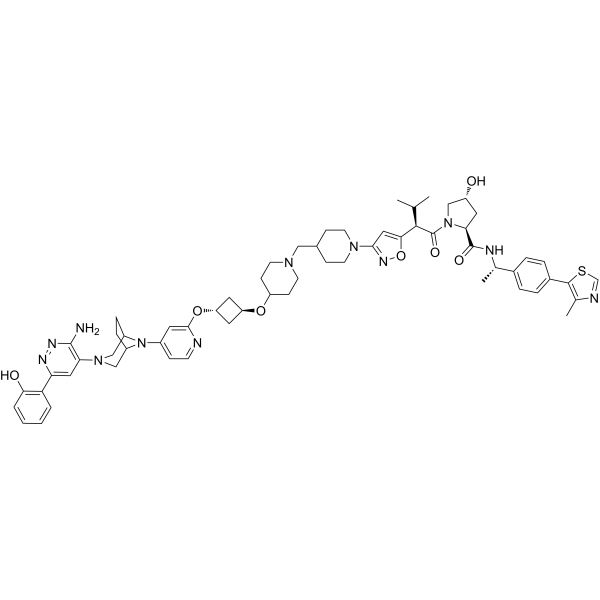Physicochemical Properties
| CAS # | 2378056-80-3 |
| Appearance | Typically exists as solid at room temperature |
| HS Tariff Code | 2934.99.9001 |
| Storage |
Powder-20°C 3 years 4°C 2 years In solvent -80°C 6 months -20°C 1 month |
| Shipping Condition | Room temperature (This product is stable at ambient temperature for a few days during ordinary shipping and time spent in Customs) |
Biological Activity
| Targets | Kd: 93 nM (SMARCA2), 65 nM (SMARCA4); DC50 for SMARCA2: 39 pM (in SW1573 cells)[1]. |
| ln Vitro | A947 has a 93 nM and 65 nM Kd value for binding affinity to the SMARCA2 and SMARCA4 bromodomains, respectively[1]. With a DC50 of 39 pM, A947 has the ability to potently degrade SMARCA2 in SW1573 cells[1]. SMARCA2/4 is ubiquitinated and degraded by A947 (100 nM, 500 nM)[1]. A947 (0-500 nM) can stop SMARCA4-mutant NSCLC cells from proliferating[1]. |
| ln Vivo | In SMARCA4-mutant NSCLC xenograft models, A947 (iv; 40 mg/kg; single-dose, 2 week or every other week, 30 days) has demonstrated activity in vivo[1]. |
| Cell Assay |
Western Blot Analysis[1] Cell Types: SW1573 cells Tested Concentrations: 0-10 nM Incubation Duration: 18 h Experimental Results: Degraded SMARCA2 with amaximal degradation of 96% in 10 nM. Cell Viability Assay[1] Cell Types: NCI-H1944 cells Tested Concentrations: 0-500 nM Incubation Duration: 7 days Experimental Results: demonstrated the dose-dependent inhibition of growth. Cell Cycle Analysis[1] Cell Types: HCC2302, NCI-H1793, RERF-LC-AI, NCI-H1944, Calu-6, NCI-H460, A427 cells Tested Concentrations: 0-500 nM Incubation Duration: 48 h Experimental Results: demonstrated G1 arrest in SMARCA4mut models. Apoptosis Analysis[1] Cell Types: NCI-H1944, NCI-H838 cells Tested Concentrations: 100 nM Incubation Duration: 50 h Experimental Results: Induced cells toward apoptotic cell death. |
| Animal Protocol |
Animal/Disease Models: SMARCA4-mutant NSCLC xenograft models Doses: 40mg/kg Route of Administration: intravenous (iv), single-dose, 2 week; intravenous (iv), every other week, 30 days Experimental Results: Rapidly diminished the tumor SMARCA2 protein levels and Dramatically diminished the tumor growth. |
| References |
[1]. Selective PROTAC-mediated degradation of SMARCA2 is efficacious in SMARCA4 mutant cancers. Nat Commun. 2022 Nov 10;13(1):6814. |
Solubility Data
| Solubility (In Vitro) | May dissolve in DMSO (in most cases), if not, try other solvents such as H2O, Ethanol, or DMF with a minute amount of products to avoid loss of samples |
| Solubility (In Vivo) |
Note: Listed below are some common formulations that may be used to formulate products with low water solubility (e.g. < 1 mg/mL), you may test these formulations using a minute amount of products to avoid loss of samples. Injection Formulations (e.g. IP/IV/IM/SC) Injection Formulation 1: DMSO : Tween 80: Saline = 10 : 5 : 85 (i.e. 100 μL DMSO stock solution → 50 μL Tween 80 → 850 μL Saline) *Preparation of saline: Dissolve 0.9 g of sodium chloride in 100 mL ddH ₂ O to obtain a clear solution. Injection Formulation 2: DMSO : PEG300 :Tween 80 : Saline = 10 : 40 : 5 : 45 (i.e. 100 μL DMSO → 400 μLPEG300 → 50 μL Tween 80 → 450 μL Saline) Injection Formulation 3: DMSO : Corn oil = 10 : 90 (i.e. 100 μL DMSO → 900 μL Corn oil) Example: Take the Injection Formulation 3 (DMSO : Corn oil = 10 : 90) as an example, if 1 mL of 2.5 mg/mL working solution is to be prepared, you can take 100 μL 25 mg/mL DMSO stock solution and add to 900 μL corn oil, mix well to obtain a clear or suspension solution (2.5 mg/mL, ready for use in animals). Injection Formulation 4: DMSO : 20% SBE-β-CD in saline = 10 : 90 [i.e. 100 μL DMSO → 900 μL (20% SBE-β-CD in saline)] *Preparation of 20% SBE-β-CD in Saline (4°C,1 week): Dissolve 2 g SBE-β-CD in 10 mL saline to obtain a clear solution. Injection Formulation 5: 2-Hydroxypropyl-β-cyclodextrin : Saline = 50 : 50 (i.e. 500 μL 2-Hydroxypropyl-β-cyclodextrin → 500 μL Saline) Injection Formulation 6: DMSO : PEG300 : castor oil : Saline = 5 : 10 : 20 : 65 (i.e. 50 μL DMSO → 100 μLPEG300 → 200 μL castor oil → 650 μL Saline) Injection Formulation 7: Ethanol : Cremophor : Saline = 10: 10 : 80 (i.e. 100 μL Ethanol → 100 μL Cremophor → 800 μL Saline) Injection Formulation 8: Dissolve in Cremophor/Ethanol (50 : 50), then diluted by Saline Injection Formulation 9: EtOH : Corn oil = 10 : 90 (i.e. 100 μL EtOH → 900 μL Corn oil) Injection Formulation 10: EtOH : PEG300:Tween 80 : Saline = 10 : 40 : 5 : 45 (i.e. 100 μL EtOH → 400 μLPEG300 → 50 μL Tween 80 → 450 μL Saline) Oral Formulations Oral Formulation 1: Suspend in 0.5% CMC Na (carboxymethylcellulose sodium) Oral Formulation 2: Suspend in 0.5% Carboxymethyl cellulose Example: Take the Oral Formulation 1 (Suspend in 0.5% CMC Na) as an example, if 100 mL of 2.5 mg/mL working solution is to be prepared, you can first prepare 0.5% CMC Na solution by measuring 0.5 g CMC Na and dissolve it in 100 mL ddH2O to obtain a clear solution; then add 250 mg of the product to 100 mL 0.5% CMC Na solution, to make the suspension solution (2.5 mg/mL, ready for use in animals). Oral Formulation 3: Dissolved in PEG400 Oral Formulation 4: Suspend in 0.2% Carboxymethyl cellulose Oral Formulation 5: Dissolve in 0.25% Tween 80 and 0.5% Carboxymethyl cellulose Oral Formulation 6: Mixing with food powders Note: Please be aware that the above formulations are for reference only. InvivoChem strongly recommends customers to read literature methods/protocols carefully before determining which formulation you should use for in vivo studies, as different compounds have different solubility properties and have to be formulated differently. (Please use freshly prepared in vivo formulations for optimal results.) |
